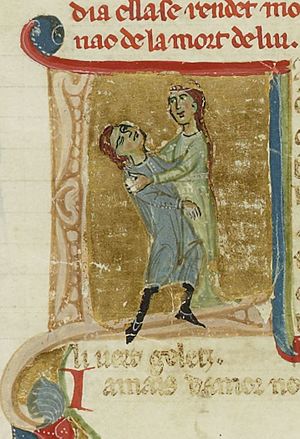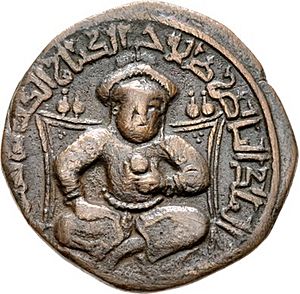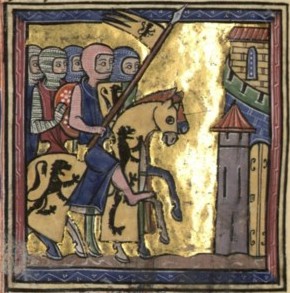Raymond III, Count of Tripoli facts for kids
Quick facts for kids Raymond III |
|
|---|---|
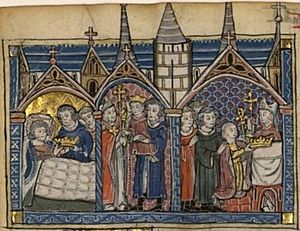
Raymond is appointed regent for the underage Baldwin V of Jerusalem by the child's uncle King Baldwin IV
|
|
| Count of Tripoli | |
| Reign | 1152–1187 |
| Predecessor | Raymond II |
| Successor | Raymond IV |
| Regents |
See list
|
| Born | 1140 |
| Died | 1187 (aged 46–47) Tripoli |
| Spouse | Eschiva of Bures |
| House | House of Toulouse |
| Father | Raymond II, Count of Tripoli |
| Mother | Hodierna of Jerusalem |
| Religion | Catholicism |
Raymond III (born in 1140, died in 1187) was the Count of Tripoli from 1152 until his death. He became count when he was still a child, after his father, Raymond II of Tripoli, was killed by a group called the Nizari Assassins. Baldwin III of Jerusalem, who was visiting Tripoli, made Raymond's mother, Hodierna of Jerusalem, the regent (someone who rules for a child king or queen). Raymond spent his early years at the royal court in Jerusalem.
When he became an adult in 1155, Raymond joined several military campaigns against Nur ad-Din, a powerful Muslim ruler. In 1161, Raymond hired pirates to attack the Byzantine Empire's coast. He did this because the Byzantine Emperor, Manuel I Komnenos, had refused to marry Raymond's sister, Melisende.
On August 10, 1164, Raymond was captured by Nur ad-Din's army during the Battle of Harim. He was held prisoner in Aleppo for nearly ten years. While he was a captive, Amalric I of Jerusalem managed the County of Tripoli for him.
Raymond was finally released after a large ransom was paid. He had to borrow money from the Knights Hospitaller to cover the cost. His marriage to Eschiva of Bures made him the Prince of Galilee. This also made him one of the richest nobles in the Kingdom of Jerusalem.
In 1174, King Amalric died, leaving his young son, Baldwin IV, as the new king. Baldwin had leprosy. As the closest male relative to the child king, Raymond was chosen to be the bailiff (or regent). During this time, Raymond stayed neutral in the fights between Nur ad-Din's successors and Saladin. This helped Saladin unite Egypt and a large part of Syria under his rule.
Baldwin IV became an adult in 1176, and Raymond's time as regent ended. He then returned to Tripoli.
Raymond and Bohemond III of Antioch tried to reduce the influence of King Baldwin's mother, Agnes of Courtenay, and her brother, Joscelin III of Edessa. They marched to Jerusalem in 1180, but their sudden arrival had the opposite effect. King Baldwin quickly arranged for his sister and heir, Sibylla, to marry Guy of Lusignan, a supporter of the Courtenays. Raymond then had to leave the kingdom.
Later, King Baldwin, who was very ill, decided that his sister Sibylla would not inherit the throne. Instead, he named her son, Baldwin V, as his heir. In 1185, Raymond's supporters convinced the king to make Raymond the bailiff for the young Baldwin V. However, Raymond's power was limited. Joscelin III of Edessa became the child's guardian, and all royal castles were given to the military orders.
After Baldwin V died in 1186, Raymond called a meeting of the kingdom's nobles in Nablus. This allowed Sibylla's supporters to take control of Jerusalem. Raymond tried to convince Sibylla's half-sister, Isabella, and her husband, Humphrey IV of Toron, to claim the throne. But Humphrey swore loyalty to Sibylla and Guy. Raymond refused to do the same and made an alliance with Saladin. This allowed Saladin to cross Galilee during his campaigns and place soldiers in Tiberias, Galilee's capital.
Raymond finally made peace with Guy after Saladin decided to launch a full attack on the crusaders in 1187. Raymond led the front part of the crusader army in the Battle of Hattin. This battle ended in a terrible defeat for the crusaders. Raymond was one of the few commanders who were not killed or captured. He escaped to Tyre and then to Tripoli, where he died (likely from a lung illness). He left Tripoli to his godson, Raymond of Antioch.
Historians have different views on Raymond III. Some, like the 12th-century historian William of Tyre, thought highly of him. Muslim historians also praised his intelligence. However, after the defeat at Hattin, some Western historians blamed him for the disaster. Today, scholars are still divided, with some agreeing with William of Tyre and others pointing out Raymond's self-interest and mistakes.
Contents
Early Life
Raymond was born in 1140. He was the only son of Raymond II of Tripoli and Hodierna of Jerusalem. His family came from France, but their ties to their homeland had weakened over time.
In 1151, Raymond, still a child, signed a document from his father. His mother, Hodierna, also signed it. She was a very active and important political figure, like her sisters, Queen Melisende of Jerusalem and Princess Alice of Antioch. Raymond's father was very jealous, which caused problems in their marriage. Queen Melisende tried to help them make peace, but Hodierna decided to leave for Jerusalem.
Soon after Hodierna left, a group of Nizari Assassins killed Raymond II at the southern gate of Tripoli. King Baldwin III of Jerusalem, who was in Tripoli, called Hodierna back to the city.
Count
Becoming Count
After Raymond II's burial, King Baldwin held a meeting. The nobles of the County of Tripoli swore loyalty to Hodierna and her two young children, Raymond and Melisende. Raymond II had said that if a young count inherited the throne, the master of the Knights Hospitaller should rule Tripoli. However, King Baldwin chose Hodierna to be the regent for her son, ignoring Raymond II's wishes.
Young Raymond spent several years at the royal court in Jerusalem. He probably learned how to be a knight there.
First Years as Ruler
Raymond became an adult in 1155. In 1157, he confirmed a gift his father had made to the Knights Templar. A few days later, Nur ad-Din, the ruler of Aleppo and Damascus, attacked King Baldwin III. Nur ad-Din then began to attack Baniyas. King Baldwin asked Raymond and Raynald of Châtillon for help. They quickly joined the king's army, and Nur ad-Din's troops left without a fight.
In August 1157, an earthquake destroyed Tripoli and other towns. In October, Thierry, Count of Flanders, arrived with a large army. King Baldwin, Raynald of Châtillon, and Raymond decided to attack Muslim towns in North Syria that had been damaged by the earthquake. They captured Harenc in January 1158, but they could not take other towns like Chastel Rouge or Shaizar.
In 1160, the Byzantine Emperor Manuel I Komnenos wanted to marry a woman from the crusader states. He asked King Baldwin III if he could marry Maria of Antioch or Raymond's sister, Melisende. Baldwin suggested Melisende, and the emperor agreed. Raymond built twelve ships to take his sister to Constantinople in a grand procession. However, the emperor changed his mind and decided to marry Maria instead.
Feeling insulted, Raymond used his new ships to raid Byzantine coasts and islands in August 1161. His pirates attacked holy places and pilgrims.
In the summer of 1164, Nur ad-Din attacked Krak des Chevaliers and Harenc. Raymond joined other crusaders to help the fortress, but they were defeated in the Battle of Harim on August 10. Thousands of crusaders died, and Raymond, Bohemond III of Antioch, Joscelin III of Edessa, and other leaders were captured.
Being a Prisoner
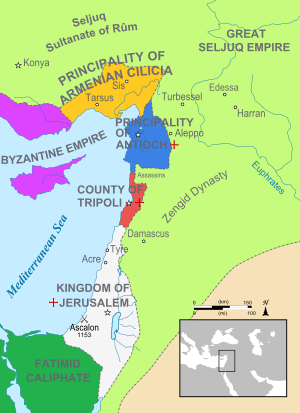
The crusader leaders captured at Harim were taken to Aleppo and imprisoned. Some reports say Raymond lived in poverty in prison, but others say he learned to read and became very educated there. Modern historians think he might have learned Arabic during this time.
Raymond told his loyal followers to accept King Amalric of Jerusalem as the ruler of Tripoli while he was captive. Amalric went to Tripoli and took control, calling himself "administrator of the county of Tripoli." Amalric managed to get Bohemond III and Thoros II, Prince of Armenia released, but Raymond remained in prison.
Amalric's rule was not easy. Nur ad-Din continued to attack crusader lands. Raymond was likely released in late 1173 or early 1174. Some historians believe Nur ad-Din released him because of growing tensions with his powerful commander, Saladin. Nur ad-Din may have seen the crusader states as a barrier between his lands and Saladin's Egypt.
Raymond had to pay a very large ransom, possibly 80,000 or 150,000 gold coins. He borrowed money from the Knights Hospitaller to pay part of it.
Count and Regent
First Time as Regent
Walter of Saint Omer, the Prince of Galilee, died in early 1174. King Amalric of Jerusalem arranged for Raymond to marry Walter's widow, Eschiva of Bures. This marriage gave Raymond control of the large region of Galilee, making him very wealthy. Raymond and Eschiva had no children together, but Raymond loved his wife and raised her children from her first marriage as his own.
King Amalric died on July 11, 1174. His only son, Baldwin, became king four days later, even though he was young and had leprosy. The king's seneschal (a high-ranking official), Miles of Plancy, took charge, but he struggled to get the army commanders to work with him.
Raymond came to Jerusalem in August 1174. He claimed the right to be regent because he was the king's closest male relative and most powerful vassal. He also argued that since he had allowed the king's father to rule Tripoli during his captivity, he deserved the same treatment. Miles of Plancy delayed the decision.
Raymond returned to Tripoli. Miles of Plancy was murdered in Acre in October 1174. The most powerful nobles and church leaders met in Jerusalem. The bishops supported Raymond's claim to be regent. After a two-day debate, Raymond was chosen as bailiff (regent). He was officially installed in a grand ceremony at the Church of the Holy Sepulchre.
Raymond allowed the king's mother, Agnes of Courtenay, to return to the royal court. He also made the learned William of Tyre the chancellor.
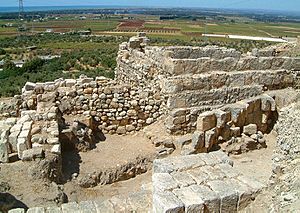
Saladin had been expanding his rule, taking over Damascus and other cities. In early 1175, Raymond gathered troops from Jerusalem and Tripoli at Arqa. However, he did not get involved in the conflict between Saladin and the Zengids. The defenders of Homs offered to free Christian prisoners, including those who were held as payment for Raymond's ransom, if Raymond helped them. Raymond wanted the prisoners released immediately, but they refused. Saladin soon returned to Homs and captured the citadel. He then made a deal with the crusaders to ensure their neutrality. After Saladin agreed to release the hostages, the crusader army went back to Tripoli.
Saladin defeated the Zengid armies and made a peace treaty that strengthened his rule in South Syria. In July, Raymond proposed a truce with Saladin, which was signed. This truce allowed Saladin to march through Oultrejordain (the eastern part of the Kingdom of Jerusalem) during his campaigns.
Military Actions
King Baldwin IV turned fifteen on July 15, 1176, ending Raymond's regency. Raymond returned to Tripoli. In 1177, Philip I of Flanders arrived with a large army of crusaders from Europe. The king wanted Philip to join a campaign against Egypt, Saladin's main power base. However, Philip kept making excuses. Rumors said that Raymond and Bohemond III convinced Philip not to join, hoping to use his army for their own benefit.
Philip went to Tripoli in October. Many knights and soldiers from Jerusalem joined him. They attacked Hama and Harenc, but could not capture Harenc.
In 1178 or 1179, Raymond attacked a group of Turkmen and took their goods. Saladin then strengthened his border defenses. In June 1179, Saladin sent horsemen to raid the Sidon region. King Baldwin gathered his troops, and Raymond joined them. They defeated the raiders, but Saladin suddenly attacked Galilee and defeated the crusaders in the Battle of Marj Ayyun. Raymond escaped to Tyre, but his stepson was captured.
Political Fights
In April 1180, Raymond and Bohemond III marched their armies to Jerusalem. They said they came to celebrate Easter, but the ill King Baldwin IV feared they wanted to remove him from power. The king quickly married his sister Sibylla to Guy of Lusignan, a knight who had recently arrived. This marriage ruined Raymond and Bohemond's plans.
Raymond and Bohemond left Jerusalem after Easter. As they were crossing Galilee, Saladin invaded the region, but their arrival forced him to retreat. Saladin and King Baldwin signed a two-year truce. However, this truce did not cover Tripoli, so Saladin launched a surprise attack on the county. Raymond had to flee to the fortress of Arqa. Saladin's army looted the northern plains, and his fleet captured the island of Ruad. Saladin withdrew his troops only after Raymond signed a truce. In the following years, Raymond strengthened Tripoli's defenses.
In April 1182, Raymond wanted to visit Galilee again, but Agnes of Courtenay and Joscelin III convinced King Baldwin IV to forbid him from entering the kingdom. Later, some powerful nobles convinced the king to let Raymond come to Jerusalem. At a meeting, Raynald of Châtillon suggested a military trip across the Jordan River to stop Saladin. Raymond disagreed, saying it would leave the western lands undefended. But Châtillon convinced most nobles to agree with his plan.
New Conflicts
Raymond went with the royal army. While he was away, Muslim troops invaded Galilee and captured 500 women. They also took a fortified cave near Tiberias. The royal army returned to the kingdom's central areas because King Baldwin suspected more raids. Raymond went to Tiberias, where he became very ill.
When Saladin attacked the castle of Bethsain in July, Raymond sent his stepson Hugh to lead the troops of Galilee and join the royal army. The royal army forced Saladin to leave. In late 1182, Raymond raided the region of Bosra.
Saladin captured Aleppo, the Zengids' last important stronghold in Syria, in June 1183. He then decided to invade the Kingdom of Jerusalem. King Baldwin ordered over 1,000 knights and 15,000 foot soldiers to gather at Saffuriya. Raymond quickly joined them. King Baldwin developed a fever and appointed Guy of Lusignan as bailiff. Saladin crossed the Jordan and looted Bethsan. Although he continued his campaign for nine days, the crusaders did not attack him. Many soldiers believed Guy's opponents refused to attack because they feared a victory would make Guy more powerful.
Relations between Guy and the king became strained. King Baldwin called a meeting to discuss the kingdom's future. Raymond, Bohemond, and the Ibelin brothers convinced the king to remove Guy from his position. They also convinced the king to name Guy's young stepson, Baldwin of Montferrat, as his heir. The child was crowned on November 20, 1183. Many nobles wanted a regent, and most agreed that only Raymond was suitable for the job. The meeting ended quickly when news arrived that Saladin was attacking Châtillon's Kerak Castle. The king gathered an army and appointed Raymond to lead it. Saladin lifted the siege when he learned the relief army was coming.
Second Time as Regent
In October 1184, Guy of Lusignan raided Bedouin tribes. This angered the king. King Baldwin then gave "the government of the kingdom and its general administration" to Raymond. Some accounts say the High Court made rules for the regency: Joscelin III was chosen as the child king's guardian, and military orders would hold all royal castles. Raymond was given Beirut to help cover the costs of running the state. The High Court also decided that if the child king died, the pope and the kings of France and England would decide who should be the next ruler: Sibylla or her half-sister, Isabella. These rules were clearly meant to limit Raymond's power.
King Baldwin IV died before May 16, 1185. Raymond had already sent people to Saladin to negotiate a truce. Saladin agreed to a four-year truce. This allowed the land to be "free from external battles" during Raymond's second regency. Saladin agreed to peace because he was fighting a coalition of Muslim rulers. Raymond could not strengthen his power during his regency because many powerful figures, including the new Grand Master of the Templars, were supporters of Guy of Lusignan.
Last Years
Leading to Hattin
Baldwin V died unexpectedly in Acre in the summer of 1186. Joscelin III convinced Raymond to go to Tiberias to prepare for a big meeting, while the Templars took the young king's body to Jerusalem. While Raymond was away, Joscelin took control of Acre and Beirut. Raymond called the nobles to Nablus. Some historians believe Raymond tried to take the throne at this meeting.
While most nobles were in Nablus, Sibylla and Guy of Lusignan attended the king's funeral in Jerusalem. Key supporters of Sibylla decided to offer her the crown without waiting for the decision of the Western monarchs, as had been agreed. Sibylla invited the nobles from Nablus to her coronation, but they refused to accept her right to rule. Raymond sent a spy to Jerusalem.
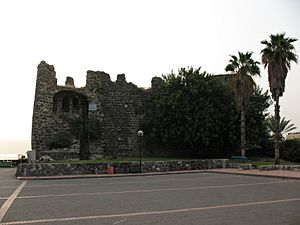
Sibylla's supporters ignored the nobles' opposition. The patriarch of Jerusalem crowned her queen before the end of September. She then placed the crown on Guy's head, and he was anointed king. Raymond and his supporters decided to choose Sibylla's half-sister Isabella and her husband, Humphrey IV of Toron, as queen and king. However, Humphrey secretly left Nablus and swore loyalty to Guy. Most nobles followed Humphrey's example. Raymond returned to Tiberias without swearing loyalty to Sibylla and Guy.
Guy accused Raymond of betrayal and invaded Galilee in October. Raymond refused to give an account of his regency, saying he had spent all royal money on running the state. Raymond decided to fight back and asked Saladin for help. Saladin sent troops to Tiberias, forcing Guy to retreat. Some sources say Saladin offered to make Raymond "an independent king."
Saladin decided to launch a full invasion against the kingdom in early 1187. The nobles convinced Guy to make peace with Raymond. Leaders from the military orders and other important figures went to Tiberias to negotiate. Saladin's son, al-Afdal, sent troops to raid the kingdom. Raymond, following his treaty with Saladin, allowed the Syrian troops to enter Galilee freely. When al-Afdal began raiding the Nazareth region, the masters of the military orders attacked the invaders, even though they were greatly outnumbered. The crusaders were almost completely destroyed at the springs of Cresson on May 1. Only a few knights escaped.
The next day, news of the disaster shocked Raymond. He quickly agreed to swear loyalty to Guy. He expelled the Muslim soldiers who had been in Tiberias because of his alliance with Saladin. Raymond and the king met near Jerusalem. Raymond knelt to the king, and Guy lifted him up, expressing regret for his irregular coronation.
Hattin and Its Aftermath
The king ordered the kingdom's troops to gather at Saffuriya. Raymond joined the royal army with all the knights from Galilee, leaving his wife in Tiberias with a small group of soldiers. Knights from Tripoli also came. On July 2, 1187, Saladin invaded Galilee and began to attack Tiberias.
The news about the siege of Tiberias caused new arguments among the crusaders. Raymond wanted to avoid a direct battle, suggesting that the town could hold out and they should wait for reinforcements from Antioch. Others accused him of cowardice. The king finally decided to attack and ordered his army to march towards Tiberias.
As lord of the region, Raymond was chosen to guide the army through Galilee. Saladin's troops attacked the rear of the crusader army. The crusaders stopped at Maskana, even though there wasn't enough water for their large army. Some blamed Raymond for this decision, but others said the king decided to stop against Raymond's advice. Saladin's troops surrounded the crusader camp.
The next day, the army continued marching towards Tiberias. Raymond led the front part of the army. A group of thirsty soldiers tried to reach the distant Sea of Galilee but were killed. Five of Raymond's knights left and joined Saladin. Raymond led a cavalry charge against Saladin's army, trying to reach the springs near Hattin. The Muslim troops opened a path without fighting. Instead of turning back, Raymond and the crusaders with him (including Raynald of Sidon and Balian of Ibelin) escaped to Safed and then to Tyre.
The rest of the crusader army was destroyed. Many of Raymond's vassals from Tripoli were captured. The towns of the kingdom, left almost defenseless, could not resist. Saladin captured almost all of them in the following month. Eschiva of Bures surrendered Tiberias to Saladin and joined Raymond in Tyre. After Saladin took Beirut on August 6, Raymond fled to Tripoli because he thought Saladin could easily capture Tyre. His old allies, Balian of Ibelin and Raynald of Sidon, soon joined him.
Raymond became very ill in Tripoli, possibly from a lung illness. Some historians say his sadness over the terrible defeat at Hattin caused his illness. Raymond had no children, so he left the County of Tripoli to his godson, Raymond, the eldest son of Bohemond III of Antioch. Raymond likely died in September 1187.
Legacy
William of Tyre thought highly of Raymond, describing him as a man with "much foresight" in politics and war. However, he also criticized Raymond's escape from the battlefield in 1179. William's writings greatly influenced later historians.
Muslim writers of the time described Raymond as intelligent and clever. One historian wrote that the crusaders "had nobody more influential than him, none braver and none more excellent in counsel." However, he also noted Raymond's bad reputation among Muslims, calling him "the devil among the Franks."
The fall of Jerusalem and most of the Holy Land after the Battle of Hattin was a huge blow to Christians. Raymond's alliance with Saladin and his escape from the battle made many Christian writers see him as a traitor. Some stories even claimed Raymond had converted to Islam, but modern historians agree these stories were made up.
Genealogical table
| Raymond's close family and relationship with neighbouring rulers | |||||||||||||||||||||||||||||||||||||||||||||||||||||||||||||||||||||||||||||||||||||||||||||||||||||||||||||||||||||||||||||||||||||||||||||||||||||||||||||||||||||||||||||||||||||||||||||||||||||||||||||||||||||||||||||||||||||||||||||||||||||||||||||||||||||||||||||||||||||||||||||||||||||||||||||||||||||||||||||||||||||||||||||||||||||||||||||||||||||||||||||||||||||||||||||||||||||||||||||||||||||||||||||||||||||||||||||||||||||||||||||||||||||||||||||||||||||||||||||||||||||||||||||||||||||||||||||||||||||||||||||||||||||||||||||||||||||||||||||||||||||||||||||||||||||||||||||||||||||||||||||||||||||||||||||||||||||||||||||||||||||||||||||||||||||||||||||||||||||||||||||||||||||||||||||||||||||||||||||||||||||||||||||||||||||||||||||||||||||||||||||||||||||||||||||||||||||||||||||||||||||||||||||||||||||||||||||||||||||||||||||||||||||||||||||||||||||||||||||||||||||
|---|---|---|---|---|---|---|---|---|---|---|---|---|---|---|---|---|---|---|---|---|---|---|---|---|---|---|---|---|---|---|---|---|---|---|---|---|---|---|---|---|---|---|---|---|---|---|---|---|---|---|---|---|---|---|---|---|---|---|---|---|---|---|---|---|---|---|---|---|---|---|---|---|---|---|---|---|---|---|---|---|---|---|---|---|---|---|---|---|---|---|---|---|---|---|---|---|---|---|---|---|---|---|---|---|---|---|---|---|---|---|---|---|---|---|---|---|---|---|---|---|---|---|---|---|---|---|---|---|---|---|---|---|---|---|---|---|---|---|---|---|---|---|---|---|---|---|---|---|---|---|---|---|---|---|---|---|---|---|---|---|---|---|---|---|---|---|---|---|---|---|---|---|---|---|---|---|---|---|---|---|---|---|---|---|---|---|---|---|---|---|---|---|---|---|---|---|---|---|---|---|---|---|---|---|---|---|---|---|---|---|---|---|---|---|---|---|---|---|---|---|---|---|---|---|---|---|---|---|---|---|---|---|---|---|---|---|---|---|---|---|---|---|---|---|---|---|---|---|---|---|---|---|---|---|---|---|---|---|---|---|---|---|---|---|---|---|---|---|---|---|---|---|---|---|---|---|---|---|---|---|---|---|---|---|---|---|---|---|---|---|---|---|---|---|---|---|---|---|---|---|---|---|---|---|---|---|---|---|---|---|---|---|---|---|---|---|---|---|---|---|---|---|---|---|---|---|---|---|---|---|---|---|---|---|---|---|---|---|---|---|---|---|---|---|---|---|---|---|---|---|---|---|---|---|---|---|---|---|---|---|---|---|---|---|---|---|---|---|---|---|---|---|---|---|---|---|---|---|---|---|---|---|---|---|---|---|---|---|---|---|---|---|---|---|---|---|---|---|---|---|---|---|---|---|---|---|---|---|---|---|---|---|---|---|---|---|---|---|---|---|---|---|---|---|---|---|---|---|---|---|---|---|---|---|---|---|---|---|---|---|---|---|---|---|---|---|---|---|---|---|---|---|---|---|---|---|---|---|---|---|---|---|---|---|---|---|---|---|---|---|---|---|---|---|---|---|---|---|---|---|---|---|---|---|---|---|---|---|---|---|---|---|---|---|---|---|---|---|---|---|---|---|---|---|---|---|---|---|---|---|---|---|---|---|---|---|---|---|---|---|---|---|---|---|---|---|---|---|---|---|---|---|---|---|---|---|---|---|---|---|---|---|---|---|---|---|---|---|---|---|---|---|---|---|---|---|---|---|---|---|---|---|---|---|---|---|---|---|---|---|---|---|---|---|---|---|---|---|---|---|---|---|---|---|---|---|---|---|---|---|---|---|---|---|---|---|---|---|---|---|---|---|---|---|---|---|---|---|---|---|---|---|---|---|---|---|---|---|---|---|---|---|---|---|---|---|---|---|---|---|---|---|---|---|---|---|---|---|---|---|---|---|---|---|---|---|---|---|---|---|---|---|---|---|---|---|---|---|---|---|---|---|---|---|---|---|---|---|---|---|---|---|---|---|---|---|---|---|---|---|---|---|---|---|---|---|---|---|---|---|---|---|---|---|---|---|---|---|---|---|---|---|---|---|---|---|---|---|---|---|---|---|---|---|---|---|---|---|---|---|---|---|---|---|---|---|---|---|---|---|---|---|---|---|---|---|---|---|---|---|---|---|---|---|---|---|---|---|---|---|---|---|---|---|---|---|---|---|---|---|---|---|---|---|---|---|---|---|---|---|---|---|---|---|---|---|---|---|---|---|---|---|---|---|---|---|---|---|---|---|---|---|---|---|---|---|---|---|---|---|---|---|---|---|---|---|---|---|---|---|---|---|---|---|---|---|---|---|---|---|---|---|---|---|---|---|---|---|---|---|---|---|---|---|---|---|---|---|---|---|---|---|---|---|---|---|---|---|---|---|---|---|---|---|---|---|---|---|---|---|---|---|---|---|---|---|---|---|---|---|---|---|---|---|---|---|---|---|---|---|---|---|---|---|---|
|
|||||||||||||||||||||||||||||||||||||||||||||||||||||||||||||||||||||||||||||||||||||||||||||||||||||||||||||||||||||||||||||||||||||||||||||||||||||||||||||||||||||||||||||||||||||||||||||||||||||||||||||||||||||||||||||||||||||||||||||||||||||||||||||||||||||||||||||||||||||||||||||||||||||||||||||||||||||||||||||||||||||||||||||||||||||||||||||||||||||||||||||||||||||||||||||||||||||||||||||||||||||||||||||||||||||||||||||||||||||||||||||||||||||||||||||||||||||||||||||||||||||||||||||||||||||||||||||||||||||||||||||||||||||||||||||||||||||||||||||||||||||||||||||||||||||||||||||||||||||||||||||||||||||||||||||||||||||||||||||||||||||||||||||||||||||||||||||||||||||||||||||||||||||||||||||||||||||||||||||||||||||||||||||||||||||||||||||||||||||||||||||||||||||||||||||||||||||||||||||||||||||||||||||||||||||||||||||||||||||||||||||||||||||||||||||||||||||||||||||||||||||
See also
 In Spanish: Raimundo III de Trípoli para niños
In Spanish: Raimundo III de Trípoli para niños
- Kingdom of Heaven (film)
Sources
Primary sources
- The Chronicle of Ibn Al-Athīr for the Crusading Period from Al-Kāmil Fī'l-ta'rīkh, Part 2: The years 541-589/1146-1193: The Age of Nur al-Din and Saladin (Translated by D.S. Richards) (2007). Ashgate. ISBN: 978-0-7546-4078-3.


